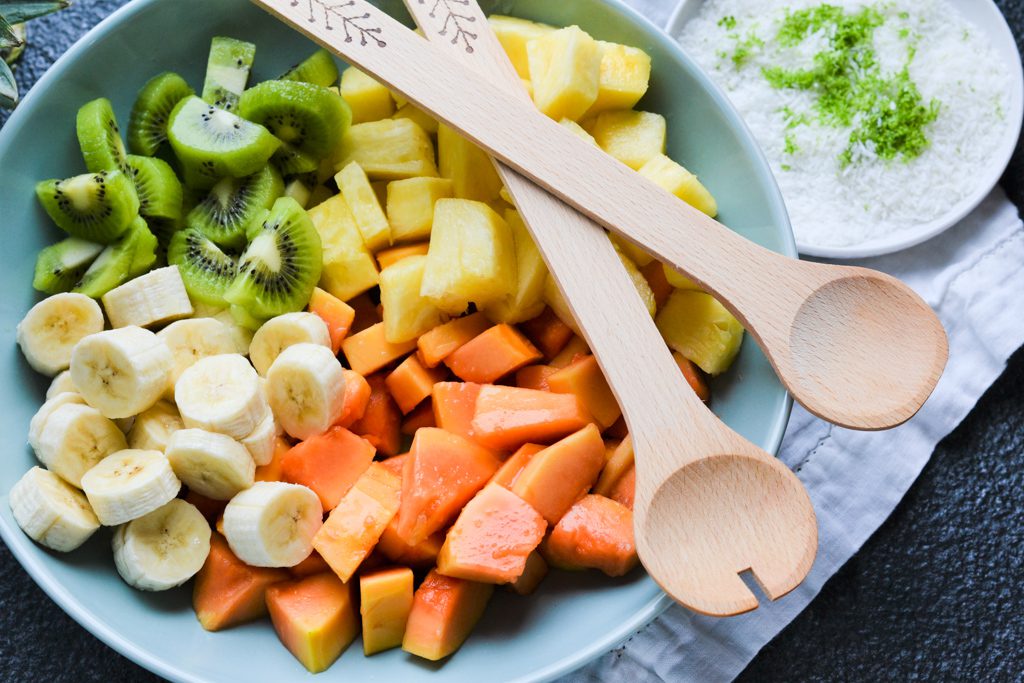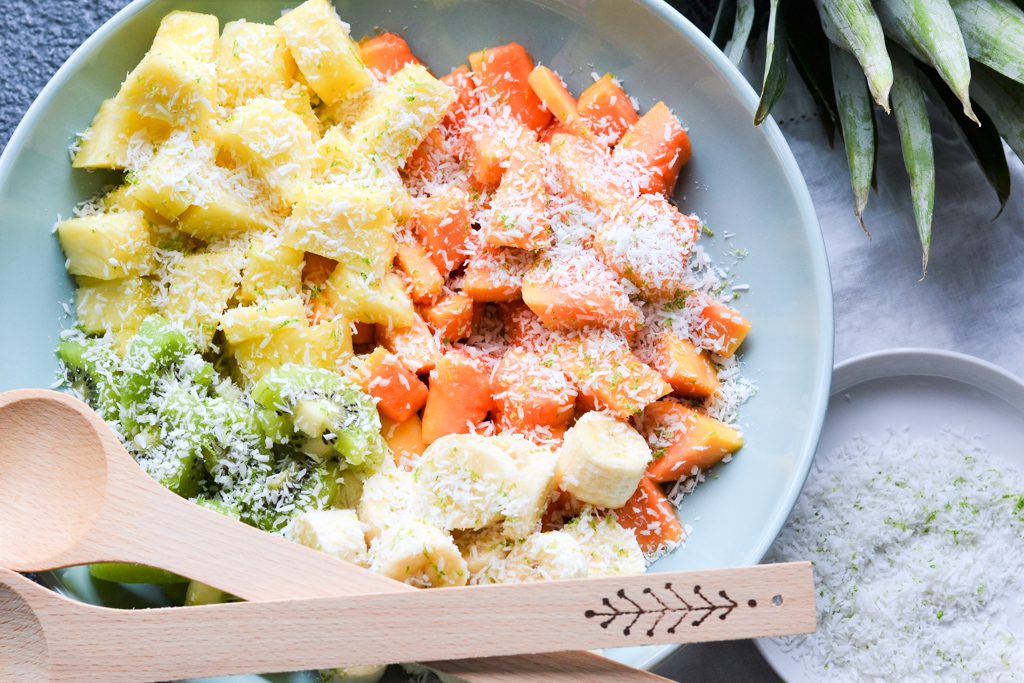Tropical Fruit Salad with fresh, juicy papaya, pineapple, bananas, and kiwi topped with shredded coconut and lime zest. With no added sugar makes the ultimate summer side dish!
Here in Colorado, it has been in the 80s all week. Every day I go out in the backyard and see all my plants and flowers growing. It’s crazy how much some of them grow in a day. I think my hostas sprouted 2 inches overnight. It’s so exciting to watch!
Since it has been so warm, we set up a little inflatable frog pool in the backyard for our 9-month-old to splash around and cool off in. Our toddler is obsessed with water, you can’t keep her out of the dog bowl. She has been running through the sprinkler and splashing in her water table. Pictured below is her watering the pots and flowers in the yard. We have been hanging out in the backyard all week and it’s starting to feel like summer!

This recipe definitely gets me in the Summer mood with all the fresh, tropical fruit. Let’s talk about what is in this delicious fruit salad and learn more about each fruit.
Ingredients in Tropical Fruit Salad

Papaya
Papaya is native to Mexico but naturally grows in the Caribbean and Florida. In the US, most commercially grown papayas are produced in Hawaii, California, Texas, and Florida. The papaya used in the recipe was actually from Guatemala. Papaya is available all year long with the peak season being early summer into fall. Papaya contains an enzyme called papain, which can aid in digestion and break down the tough protein chains found in muscle meat. People have used papaya to tenderize meat for thousands of years. I have never tried papaya as a meat tenderizer, but will definitely have to give it a shot. It is an excellent source of vitamin C and A, potassium, and calcium.
To ensure ripeness, papaya should be yellow to orange-red in color (a few green spots are fine). Its skin should be firm yet yield gentle pressure similar to an avocado. It should have a sweet smell. The seeds and flesh are both edible.
For this recipe, wash and peel the papaya with a vegetable peeler. Cut the papaya in half longways and scoop out the seeds using a spoon. Cut into cubes.
Pineapple
Most people associate pineapple with Hawaii, but Costa Rica is our leading supplier of fresh pineapples. They are available year-round but peak season is from March to July. Pineapples are a great source of vitamin C, manganese, an enzyme called bromelain, as well as antioxidants.
Choose a fresh-looking pineapple with green leaves and a firm shell with a small amount of give when pushed. A sweet pineapple smell at the base should be present.
For this recipe, start by cutting off the crown and bottom. Stand the pineapple up and cut from the bottom down peeling in strips. Cut deep enough to remove all of the skin and nodules. Cut the pineapple in half then lay the pineapple flat side down on the cutting board. Slice into lengthwise strips. Remove the core at an angle. Slice the strips into bite-sized chunks.

Bananas
Bananas are native to Southeast Asia and grown in many of the warmer climates. They are one of the most popular fruits in the world. Containing fiber, potassium, vitamins b6 and c, and antioxidants. Bananas are a rich source of carbs, which are mainly starch in unripe bananas. The starch is converted to sugars when ripe. They end up having less than 1 percent starch when fully ripe.
For this recipe, simply peel the banana then slice.
Kiwi
Kiwi is native to China. Seeds were brought out of China by missionaries to New Zealand at the turn of the century. Kiwi plants were later brought to California. They are full of nutrients such as vitamin C, K, E, folate, and potassium. They contain plenty of antioxidants and are a good source of fiber.
Look for firm, unblemished kiwi. They should give to slight pressure. A firm kiwi needs more time to ripen.
Shredded Coconut
Coconut is high in fat, but absorbed in your small intestine and used by your body to produce energy. Coconut is high in fiber and contains important minerals such as manganese as well as antioxidants. This Terrasoul organic shredded coconut is my favorite and the 2 pack is a great deal! It’s unsweetened, medium flake, it is a perfect size and has the best texture (in my opinion).
This recipe uses unsweetened shredded coconut, but feel free to use sweetened shredded coconut if desired.
How to Make Tropical Fruit Salad

- Cut all the fruit as mentioned above and zest the lime.
- Transfer fruit to a large serving bowl.
- Top fruit with shredded coconut and lime zest.
- You can toss it all together or leave the fruit separated. Serve or chill until ready. Salad is best eaten the same day.

Storage
Store any leftover fruit or fruit salad in an airtight container in the refrigerator for up to 4 days.
Variations
If any of the fruit is not available or not in season you can leave it out. Another nice addition or replacement for this salad would be mangoes. But if you see any other tropical fruits at the store, feel free to add them in.
Other Yummy Recipes

Tropical Fruit Salad
Equipment
- cutting board
- knife
- large bowl
Ingredients
- 2½ cups fresh papaya cubed
- 2½ cups fresh pineapple cubed
- 2 large bananas sliced
- 3 ripe kiwi peeled, sliced then cut in half
- ⅓ cup shredded coconut unsweetened
- 1 lime zest
Instructions
- Cut all the fruit and zest the lime. (For tips on how to cut each fruit see above).Transfer to a large serving bowl.
- Top with shredded coconut and lime zest.Toss if desired or leave the fruit separated.Serve or chill in the refrigerator until ready to enjoy. Salad is best eaten the same day.
- Store leftovers in an airtight container in the refrigerator for up to 4 days.

Leave a Reply